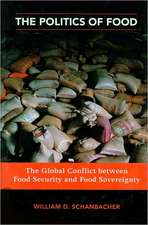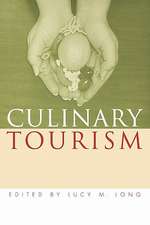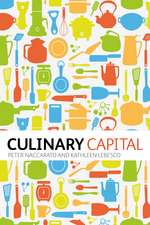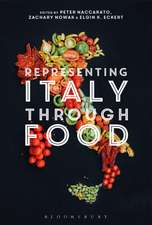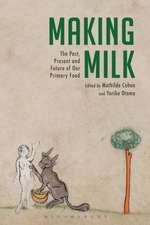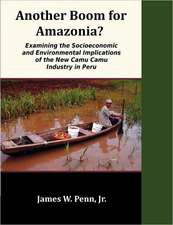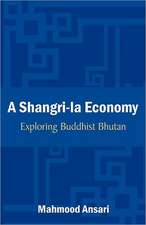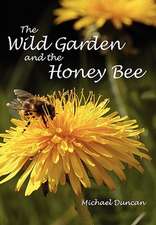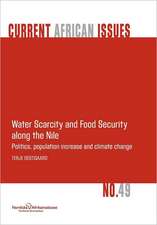The Bloomsbury Handbook of Food and Popular Culture
Editat de Kathleen Lebesco, Dr Peter Naccaratoen Limba Engleză Hardback – 13 dec 2017
Preț: 728.15 lei
Preț vechi: 1285.59 lei
-43% Nou
Puncte Express: 1092
Preț estimativ în valută:
139.33€ • 145.86$ • 115.29£
139.33€ • 145.86$ • 115.29£
Carte disponibilă
Livrare economică 15-29 martie
Preluare comenzi: 021 569.72.76
Specificații
ISBN-13: 9781474296243
ISBN-10: 1474296246
Pagini: 368
Ilustrații: 10 bw illus
Dimensiuni: 169 x 244 x 25 mm
Greutate: 0.82 kg
Editura: Bloomsbury Publishing
Colecția Bloomsbury Academic
Locul publicării:London, United Kingdom
ISBN-10: 1474296246
Pagini: 368
Ilustrații: 10 bw illus
Dimensiuni: 169 x 244 x 25 mm
Greutate: 0.82 kg
Editura: Bloomsbury Publishing
Colecția Bloomsbury Academic
Locul publicării:London, United Kingdom
Caracteristici
Contributors from disciplines such as food studies, communication, journalism, history, anthropology, sociology, literature, education, childhood studies, health sciences, architecture, and design make this a truly interdisciplinary resource
Notă biografică
Kathleen LeBesco is Senior Associate Dean for Academic Affairs at Marymount Manhattan College, USA. Peter Naccarato is Professor of English and World Literatures at Marymount Manhattan College, USA.
Cuprins
Notes on Contributors Editors' Introduction: Where Popular Culture Meets Food Studies, (Kathleen LeBesco, Marymount Manhattan College, USA and Peter Naccarato, Marymount Manhattan College, USA) Part One: Vicarious Consumption: Media and Communication 1. Gender and Food Television: A Transnational Perspective on the Gendered Identities of Televised Celebrity Chefs, (Jonatan Leer, Aarhus University, Denmark) 2. Food and Cinema: An Evolving Relationship, (Laura Lindenfeld, Stony Brook University, USA and Fabio Parasecoli, New School, USA) 3. Global Food, Global Media, Global Culture: Representations of the New Indian Cuisine in Indian Media, (Rohit Chopra, Santa Clara University, USA) 4. Tasting the Digital: New Food Media, (Isabelle de Solier, University of Melbourne, Australia) 5. Cooking, Eating, Uploading: Digital Food Cultures, (Deborah Lupton, University of Canberra, Australia) Part Two: Visceral Practices: Material Cultures of Eating 6. A History of Food in Popular Culture Over the Life Span, (Amy Bentley, New York University, USA and Shayne Figueroa, New York University, USA) 7. Cooking at Home: The Cultural Construction of American "Home Cooking" in Popular Discourse, (Jessamyn Neuhaus, State University of New York Plattsburgh, USA) 8. Trends in Food Retail: The Supermarket and Beyond, (Shelley Koch, Emily & Henry College, USA) 9. Haute, Fast, and Historic: Restaurants and the Rise of Popular Culture, (David Beriss, University of New Orleans, USA) 10. No Longer Tied to the Local: Street Food's Technological Revolution, (Bryan W. Moe, Biola University, USA and Kendall Robbin Shurance, University of the Pacific, USA) Part Three: Aesthetics of Food 11. Food, Design, and Innovation: From Professional Specialization to Citizen Involvement, (Fabio Parasecoli, New School, USA) 12. Food and Urban Design: Urban Agriculture as Second Nature?, (Andre Viljoen, University of Brighton, UK and Katrin Bohn, University of Brighton, UK) 13. Procrustean Boxes: Architecture and Slaughter, (Paulette Singley, Woodbury University, USA) 14. Food and Art: Changing Perspectives on Food as a Creative Medium, (Yael Raviv, Director of the Umami Food and Art Festival, USA) 15. A Cultural History of Restaurants in Art Museums: Collaborative Creativities, (Irina D. Mihalache, University of Toronto, Canada) 16. Performing With(in) Food, (David Szanto, Concordia University, Canada) Part Four: Socio-Political Considerations: Contemporary Debates and Trends 17. From Food Advertising to Digital Engagements: Future Challenges for Public Health, (Rebecca Wells, City, University of London, UK and Martin Caraher, City, University of London, UK) 18. Scourge or Savior? The Complex Relationship between Food and Science, (Rachel A. Ankeny, University of Adelaide, Australia and Heather J. Bray, University of Adelaide, Australia) 19. Nutrition, Health and Food: "What should I eat?", (Jessica Mudry, Toronto Metropolitan University, Canada) 20. A Kind Diet: Cultivating Consumer Politics, Status, and Femininity through Ethical Eating, (Josée Johnston, University of Toronto, Canada, Kate Cairns, Rutgers University-Camden, USA, and Merin Oleschuk, University of Toronto, Canada) 21. Food and Cultural Heritage: Preserving, Re-inventing and Exposing Food Cultures, (Elisa Ascione, The Umbra Institute, Italy) 22. A smiling face is half the meal*: Setting a place for culture in food advocacy, (Lori Stahlbrand, New College, University of Toronto, Canada and Wayne Roberts, Food Analyst and Consultant, Canada) 23. What is (not) Food? The Construction of Food Waste as a Social Problem, (Leda Cooks, University of Massachusetts, Amherst, USA) Notes Index
Recenzii
Food is everywhere in popular culture, and this is an exemplary collection that helps us study that phenomenon critically as the product of subordinated peoples that nevertheless might serve the interest of the dominant classes. This handbook provides refreshing new tools, concepts and instances of that dialectic. It is exceptional in providing breadth and depth in comparative global perspective.
The editors of this volume could not have done better in bringing together such a luminary cast of influential scholars on the topic. This exciting collection is essential reading for anyone interested in two of life's fundamental pursuits: food, and how we frame what we put in our bodies.
Given the prominence of food in popular discourse of recent decades, this solid collection is a welcome addition to the food studies literature. A remarkable cast of contributors offers concise discussions of topics including traditional and emerging media, restaurants, street food and home cooking, patterns of consumption across age, gender, class and race, to food issues such as nutrition, advocacy and waste.
The Bloomsbury Handbook of Popular Culture and Food underscores the serious and often determinant role that culture, in its most broadly accessible form, plays in establishing hierarchies of people, resources, and ideas, affecting all manner of social life. LeBesco and Naccarato provide the scaffolding of clearly linked sections, from media to materiality and aesthetics to arguments, creating a manageable resource for all. All the articles offer historical contexts for the emergence of food phenomena without reducing the popular to the ephemeral.
LeBesco and Naccarato (both, Marymount Manhattan College) assembled a dream team of food and culture scholars for this definitive handbook on the topic. Valuable as a classroom reader and for scholars new to the field, this is a welcome multivoice complement to the groundbreaking Bite Me: Food in Popular Culture, by Fabio Parasecoli, who is one of the contributors to the present volume. Summing Up: Essential. All readers.
The editors of this volume could not have done better in bringing together such a luminary cast of influential scholars on the topic. This exciting collection is essential reading for anyone interested in two of life's fundamental pursuits: food, and how we frame what we put in our bodies.
Given the prominence of food in popular discourse of recent decades, this solid collection is a welcome addition to the food studies literature. A remarkable cast of contributors offers concise discussions of topics including traditional and emerging media, restaurants, street food and home cooking, patterns of consumption across age, gender, class and race, to food issues such as nutrition, advocacy and waste.
The Bloomsbury Handbook of Popular Culture and Food underscores the serious and often determinant role that culture, in its most broadly accessible form, plays in establishing hierarchies of people, resources, and ideas, affecting all manner of social life. LeBesco and Naccarato provide the scaffolding of clearly linked sections, from media to materiality and aesthetics to arguments, creating a manageable resource for all. All the articles offer historical contexts for the emergence of food phenomena without reducing the popular to the ephemeral.
LeBesco and Naccarato (both, Marymount Manhattan College) assembled a dream team of food and culture scholars for this definitive handbook on the topic. Valuable as a classroom reader and for scholars new to the field, this is a welcome multivoice complement to the groundbreaking Bite Me: Food in Popular Culture, by Fabio Parasecoli, who is one of the contributors to the present volume. Summing Up: Essential. All readers.

